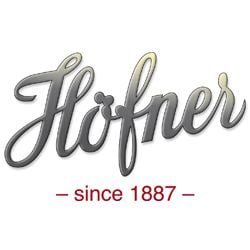Type Private Website hofner.com Founded 1887 | Industry Musical instruments Area served Worldwide Founder Karl Höfner | |
 | ||
Products Electric, acoustic, resonator and classical guitarsBass guitarsUkulelesViolinsViolasCellosDouble bassesBows Profiles | ||
Karl Höfner GmbH & Co. KG is a German (originally Austro-Bohemian) manufacturer of musical instruments, with one division that manufactures guitars and basses, and another that manufactures other string instruments, such as violins, violas, cellos, double basses and bows for stringed instruments.
Contents
- Paul mccartney h fner bass sound test
- Company history
- Changes of ownership
- Europe
- USA
- Selected models
- Beatles
- Paul McCartney
- Hfner 5001 bass players
- Hfner 5002 bass players
- Hfner guitar users
- References
Much of Höfner's popularity is attributed to Paul McCartney's use of the Höfner 500/1 bass throughout his career. This violin-shaped model is commonly referred to as the "Beatle bass."
Paul mccartney h fner bass sound test
Company history
The Höfner company was founded by luthier Karl Höfner in the city of Schönbach in 1887, at a time when the city, later to become part of the Czech Republic, was populated by Germans. He soon became the largest manufacturer of string instruments in the country. His sons Josef and Walter joined the company around 1920, and began spreading the brand's reputation worldwide. The company became involved in production for the Germany army in World War II producing wooden crates and soles for boots. After the war Germans were expelled from the Sudetenland and Hofner was forced to move to West Germany. The company initially moved to an ex-work camp at Möhrendorf in 1948 but soon became involved in the development of a new township and factories in Bubenreuth. The new Höfner factory was opened in 1950. This was expanded three times between 1953 and 1960. Karl Höfner, the founder, lived to see the company revival and died in Bubenreuth in 1955. In 1964 a further factory was built at Hagenau about 5 km from Bubenreuth. This was used for the machining of wooden parts that were then assembled at Bubenreuth. The factory at Hagenau was expanded twice in the 1970s.
The daughter of Walter Höfner, Gerhilde, began working for the company in the mid 1950s taking an active part in all aspects of management. Her husband, Christian Benker, joined the company in 1963. They would together become the driving force for the company as Josef and Walter entered retirement in the 1970s.
Changes of ownership
In 1994, Höfner became part of the Boosey & Hawkes Group, and was able to expand and upgrade its facilities with the influx of cash. In 1997, the company moved from Bubenreuth to Hagenau.
After a near-bankruptcy in 2003 Boosey & Hawkes sold its musical instrument division (including the Höfner and Buffet Crampon companies) to The Music Group, a company formed by rescue buyout specialists Rutland Fund Management, for £33.2 million.
Höfner remained a part of this conglomerate until December 2004, when The Music Group sold the company to Klaus Schöller, who had been the General Manager of Höfner for many years, and to his wife Ulrike Schrimpff, the Finance Director at Höfner. Klaus Schöller and Ulrike Schrimpff remain as the owners of the business today.
Europe
The Höfner company has always been responsible for much of its own distribution within Europe.
The exceptions to this have been:
USA
In 2005, Höfner's USA distribution was picked up by Chicago firm Classic Musical Instruments (CMI). This company ceased trading in 2012 and distribution passed to Musical Distributors Group based in New jersey, USA.
Selected models
The names of these guitars were devised by the Selmer company for the UK market. Elsewhere, they were known by model numbers.
Beatles
Beatles guitarists George Harrison and John Lennon used Höfner electric guitars. Harrison used a President model and a Club 40 early on in his association with the group. Lennon's first electric guitar was a Club 40 model purchased in 1959 from Hessy's music store in Liverpool. He used this for about one year then purchased a Rickenbacker "Capri" model. The Club 40 was briefly loaned to Paul McCartney and then it was sold. The band's original bassist Stuart Sutcliffe played a Höfner 500/5 Bass.
Paul McCartney
The company is most famous through its association with Beatles singer and instrumentalist Paul McCartney, who is a longtime user of the Höfner 500/1 model hollow-body electric bass, first manufactured in 1956.
McCartney played two left-handed 500/1 basses during most of the group's career – a 1961 model with pickups mounted close together towards the neck, and a 1963 model, with the second pickup mounted closer to the bridge. McCartney used the 1961 bass until the recording of With The Beatles in late 1963, when he obtained his second 500/1. McCartney used his 1963 bass almost exclusively during The Beatles' touring career, using his 1961 bass (which was repaired and refinished in 1964) as a backup. Although by 1965 McCartney had begun using a Rickenbacker bass in-studio, he did bring out his 1961 model for the "Revolution" promo film in 1968 and for the documentary Let It Be the following year. During the shooting, however, the 1961 bass was stolen, and McCartney used his newer Höfner for the remainder of the film, including the famous rooftop performance. McCartney has continued to use his 1963 Höfner extensively throughout his solo career and continues to use it today.
